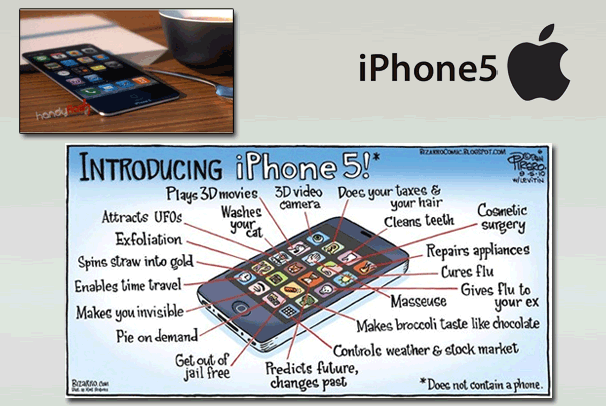I’ve been following the lead-up to yesterday’s Apple iPhone announcement, as I’m just out of contract on my original iPhone 3G (yes, Canadian carriers only offered 3-year contracts, unlike US carriers who offered 2-year deals). My iPhone 3G still works well: I’m still happy with it overall, but I’m starting to suffer from “aging hardware syndrome”. More and more of the apps I’ve been using are being updated to use the newer capabilities of more recent iPhones and no longer run on my phone. So far, it’s just been trivial stuff (games and non-critical apps) that I miss but didn’t depend on. It’s only a matter of time before one of the applications I depend on (like my time-tracking and billing software or my personal finance app) is no longer supported on the 3G. At that point, I’ll have to either jump to a newer iPhone or find equivalent apps that work on Android phones.
Yesterday’s announcement seems to have caused a lot of wailing in certain iPhone communities — as far as I can tell, mainly because Apple chose to call the new phone the “iPhone 4S” instead of “iPhone 5”. Yes, some people are upset because of nomenclature, even if the updated features are otherwise a nice upgrade over the existing iPhone 4. I’m sure there’s a term in psychology to describe that phenomenon.
Here’s an overview of the new iPhone and its headline software feature, Siri:
Siri really works, and it’s quite clever
I got some time to test it hands-on, in a booth in a fairly busy room of journalists. “What’s the weather like outside?” I asked. It came back with the weather in London (where I was). “What’s my father’s email address?” It came back with two email addresses for the person designated in the address book as “father”. Not what you’d call a comprehensive test, but it shows that it’s location-aware, context-aware, and works without training. (By contrast, I just tried “Siri app” on voice search on my Google Nexus S running Gingerbread: it took me to the web page for Syria.)Siri is integrated through the whole phone
You press the home button and the interface comes up. Then ask it anything. It’s very neat. It uses Siri’s servers, so you’ll need a working connection.
I don’t know that I’d get much use of the Siri features, but I’m sure it will move a lot of phones for the “coolness” factor.
The iPhone 4S really does look and feel exactly like the iPhone 4
There’s no difference at all, externally. Apparently the iPhone 4S is very slightly heavier — 139g (4.9oz) v 136g (4.8oz) — but you’d need a very sensitive hand to detect it.
This is probably a good move on Apple’s part (aside from the well-publicized complaints about the iPhone 4’s antenna issues), as it keeps all the companies that produced accessories for the iPhone 4 happy — they don’t need to create a whole new line of things for the iPhone 4S. The push for mobile phones to standardize on mini-USB connectors is why Apple will be selling dongles to convert from the current 30-pin connector on the iPhone to mini-USB. Again, it meets the expectations of both regulators and third-party manufacturers. I suspect Apple will be pushed to provide the dongles as standard equipment for European markets.
The camera in the iPhone 4S is now an 8MP (up from 5MP in the last model), and is claimed to be much faster:
Taking pictures on the 4S is much quicker, and taking extra pictures is too
I tried the camera on taking pictures, and the setup is really fast. It takes more pictures quickly too — almost like firing the motordrive on an SLR camera. Apple says it takes 1.1 second to get to the “click” part — faster than any in a list it provided — and that it’s then just 0.5 second to take another one. It’s impressive: camera setup delay is one of the niggles of modern life (especially smartphone life) that has crept up on us without anyone doing very much.
Overall, the 4S looks to be a nice, incremental upgrade over the iPhone 4, but Siri is the most interesting new development.
In other news, however, Apple’s recent resort to “lawfare” against Samsung in Europe may rebound badly:
Apple’s new iPhone 4S faces the prospect of court injunctions in France and Italy from the Korean electronics firm Samsung, which says the phones breach patents it owns on wireless communications.
It is an escalation of the struggle between Samsung and Apple, who are fighting a number of increasingly bitter court battles in various territories around the world. Samsung, which is challenging Apple for the title of the world’s biggest maker of smartphones, says it plans to file preliminary injunctions in Paris and Milan on the basis that the iPhone 4S, announced in California on Tuesday night and expected in a number of countries including the UK from 14 October, infringes its patents on WCDMA technology.
Update: Speaking of Android phones, here’s Alun Taylor with a list of ten smartphone alternatives to the iPhone 4S:
Yes folks, it’s that time again when across the land otherwise rational and even sensible adults feel the need to whip themselves into a frenzy over the pending arrival of the latest iPhone.
To be honest, I find the whole charade rather entertaining and have taken to sauntering over to the Trafford Centre come launch day, grabbing a cup of coffee and a sticky bun, pulling up a chair and making fun of the twerps lined up outside the Apple Store opposite.
Yes, I know it’s wrong, but just like laughing at Daily Mail readers or at anyone who voted Liberal Democrat in the last general election, I simply can’t help it.
With Android devices now outselling iOS phones by two-to-one there are many, many alternatives if you want a good smartphone with access to a shed-load of apps but don’t want to take the Apple shilling.
So here are ten of the best Android-powered alternatives. In case you’re wondering why I’ve avoided any of the recent 3D phones like HTC’s Evo 3D or LG’s Optimus 3D, that would be because it’s a stupid technology bereft of point or purpose.
Remember, if none of these handsets put their hands up your dress, the next few months we will see the arrival of Samsung’s phenomenal 5.3in Galaxy Note; Sony Ericsson’s 1.4GHz powerhouse the Xperia S; Google’s Android 4.0-packing Nexus Prime; and LG’s LU6200 with its 4.5in, 1280 x 720 IPS screen. Choice — by gum, it’s a wonderful thing.
Update, the second: Joey deVilla explains the prospective iPhone 4S customer dilemma:


 Touring the wineries of Prince Edward County? Plan your trip with WineTour, and find your way around the area with ease. We’ve collected all of the details you need to get the most out of your visit — so you’ll know what’s on, where the nearest wineries are, and what hours they’re open.
Touring the wineries of Prince Edward County? Plan your trip with WineTour, and find your way around the area with ease. We’ve collected all of the details you need to get the most out of your visit — so you’ll know what’s on, where the nearest wineries are, and what hours they’re open.


